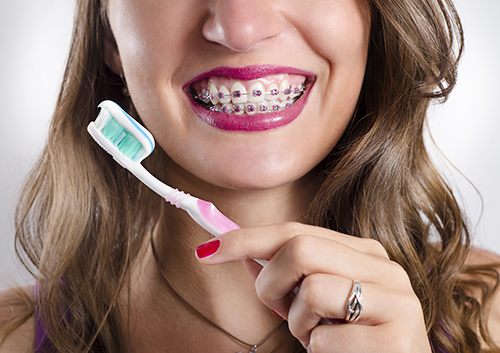Spot Check
September 23rd, 2020

After all your hard work, and months of orthodontic treatment, the big day is finally here—your braces are coming off! What you want to see: beautiful, straight teeth perfectly aligned to create a comfortable, healthy bite. What you don’t want to see: a collection of whitish spots dotting the enamel around your gum line or outlining the spot where your brackets used to be.
What are these spots? Can they be removed? And, most important, how do you avoid them?
Decalcification
Those white spots are caused by decalcification, or the removal of the minerals, especially calcium and phosphorus, that strengthen our enamel. How does this removal take place? When bacteria and plaque remain on the teeth, they produce acids that eat away at these minerals. The result is a weakened, discolored white spot in the enamel. Unfortunately, because many orthodontic patients don’t brush thoroughly around their braces, decalcification is an all-too-common problem.
Treating Decalcification
You might need cosmetic dentistry to eliminate or reduce white spots on the enamel. In some cases, they will fade over time, or teeth whitening can help. In more stubborn cases, tooth bonding or veneers can cover the affected enamel.
Preventing Decalcification
But, obviously, prevention is always better than treatment. Here are some of the ways to keep your enamel healthy and looking its best:
- Brush thoroughly after every meal.
Getting rid of the bacteria and plaque on your enamel and around your gum line will greatly reduce your chances of decalcification—and cavities. Brush after every meal, and talk to us about the best products and techniques for cleaning your teeth and appliances. And be sure to spend the extra time you’ll need for brushing around your braces.
- Floss
Even though it can be more difficult to floss with brackets and wires, it’s essential for removing plaque. We have suggestions for special flosses designed for braces wearers, and how best to use them. A water flosser can be helpful for reducing plaque if other flossing methods aren’t working.
- Use fluoride toothpaste
Fluoride actually helps remineralize our teeth, replacing the important minerals that have been lost to acid attacks. We might also suggest remineralizing toothpastes or a fluoride rinse.
- Watch your diet
Acidic foods increase the acidity levels in your mouth, sugars give bacteria the fuel they need to produce acids, and sticky foods allow bacteria to remain on teeth and braces longer. We’ll give you suggestions on the best foods to keep your teeth healthy (and your braces intact) while you’re undergoing treatment.
- Have your teeth cleaned regularly
Your dental professional will be able to remove plaque and tartar that home brushing has missed.
- Work with us!
If we let you know that you need to spend more time on your cleaning routine, or that you need to be more thorough when you brush and floss, take our suggestions to heart. We are happy to show you the most effective way to clean around your braces. Dr. Andrew Schwartz can recommend the best dental products for your specific needs. We can suggest rinses and toothpastes that will help. We’ll let you know how much time you should spend brushing and how often.
If you have any questions at all about keeping your teeth and braces their cleanest, we are here to help. Always feel free to talk to our Washington DC team about concerns you might have about decalcification, discoloration, or any other potential problems. We are want to make sure that when your braces come off, you have every reason to smile!



